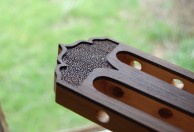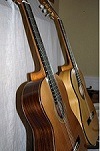Welcome to one of the most active flamenco sites on the Internet. Guests can read most posts but if you want to participate click here to register.
This site is dedicated to the memory of Paco de Lucía, Ron Mitchell, Guy Williams, Linda Elvira, Philip John Lee, Craig Eros, Ben Woods, David Serva and Tom Blackshear who went ahead of us.
We receive 12,200 visitors a month from 200 countries and 1.7 million page impressions a year. To advertise on this site please contact us.
|

|
|
back doming question from a beginner
|
You are logged in as Guest
|
|
Users viewing this topic: none
|
|
Login  | |
|

   
wfrancis86
Posts: 36
Joined: Jun. 30 2012

|
 RE: back doming question from a beginner (in reply to wfrancis86) RE: back doming question from a beginner (in reply to wfrancis86)
|
|
|
Thanks Andy for the clarification. It seems to make sense for the most part. Would you mind saying a bit more about shaping the sides? I understand that the soundboard and neck are fairly level (minus the 2mm-ish ramp in the neck) to keep tension in the top minimal. Whereas the back is actually tapered, wider in the back, more narrow at the neck. In my case, I am working from the Santos Hernandez 1933 Courtnall flamenco plan, so 96mm at the back and 87mm at the neck. But what about the arch laterally across the endblock at the bottom of the instrument, and conversely the arch at the heel/foot? The soundboard side makes sense to me, just conform it to the soundboard's dome, but were you suggesting Andy, that the sides on the backside are arched a bit laterally and then the back is pushed into this form?
Also, what would be a ballpark figure for a back dome? This is my first guitar so I really have no idea where to start. I think the Courtnall plan says top and back doming varies 2.5 to 3mm or something around there; not all that specific. My solera is domed to about 2.5mm around the bridge area at its deepest, and my neck ramp is at 2mm.
|
|
|
|
REPORT THIS POST AS INAPPROPRIATE |
Date Sep. 25 2012 15:45:21
 |
|

   
Andy Culpepper
Posts: 3023
Joined: Mar. 30 2009
From: NY, USA

|
 RE: back doming question from a beginner (in reply to wfrancis86) RE: back doming question from a beginner (in reply to wfrancis86)
|
|
|
quote:
Thanks Andy for the clarification. It seems to make sense for the most part. Would you mind saying a bit more about shaping the sides? I understand that the soundboard and neck are fairly level (minus the 2mm-ish ramp in the neck) to keep tension in the top minimal. Whereas the back is actually tapered, wider in the back, more narrow at the neck. In my case, I am working from the Santos Hernandez 1933 Courtnall flamenco plan, so 96mm at the back and 87mm at the neck. But what about the arch laterally across the endblock at the bottom of the instrument, and conversely the arch at the heel/foot? The soundboard side makes sense to me, just conform it to the soundboard's dome, but were you suggesting Andy, that the sides on the backside are arched a bit laterally and then the back is pushed into this form?
Also, what would be a ballpark figure for a back dome? This is my first guitar so I really have no idea where to start. I think the Courtnall plan says top and back doming varies 2.5 to 3mm or something around there; not all that specific. My solera is domed to about 2.5mm around the bridge area at its deepest, and my neck ramp is at 2mm.
I guess everyone shapes the profile of the sides a little differently, and it's pretty hard to describe in words....
Me personally I prefer to have a spot maybe 1 inch below the waist be the highest point (not a point but a gentle curve), and have it taper down about 5-6 mm towards the foot, and have the top of the tail block be around that same level as that highest point, maybe 1 mm lower. When the back gets glued in it's arched side to side of course, and it also gets a front to back arch because of that taper towards the heel, AND because the center of the lower bout where that brace is is still going to be higher than where the back glues to the tail block even if the sides are at the same level.
I don't use a radius dish but I have radius blocks about 20" long, 2 1/4" wide and about 2" thick. I have sandpaper on those and use the concave one to sand the radius angle onto the top of the sides/linings, so the edge of the back doesn't get distorted when it's glued on.
An arch of 3 mm sounds fine, I use a 20' radius which works out to about 3 mm I think.
_____________________________
Andy Culpepper, luthier
http://www.andyculpepper.com
|
|
|
|
REPORT THIS POST AS INAPPROPRIATE |
Date Sep. 26 2012 21:01:54
 |
|

   
estebanana
Posts: 9351
Joined: Oct. 16 2009

|
 RE: back doming question from a beginner (in reply to wfrancis86) RE: back doming question from a beginner (in reply to wfrancis86)
|
|
|
I hate to be the turd in the punch bowl, and this is not going to be very diplomatic, but ya'll work too hard. The way to do it with out making a bunch of jigs and stuff on a first guitar is much more fundamental. Of course some people love to make jigs and the jig meisters should jig away.
All you have to do to brace a back is get a lath of flexible wood about 1/4" thick and 1" wide and 16" long.
Take the brace and lay it flat on it's side. Make a pencil mark on each end about 3mm deep. Lay the brace on a shooting board so it over hangs and then simply plane from end to end to a make along graceful curve. Aim from the middle to the mark on the end. After about four to six passes the brace will be rough curved. Tighten the throat of the plane, pull in the blade, and then pass from end to end to smooth it out. Peter Tsiorba has a curve scraped into the sole of a wooden Japanese plane. All he does is pass the plane over the brace and the curved sole causes it to cut a path and it curves the brace! Magic.
Take the back, put some glue on the brace, put the flexible lath under the back, under the brace. Clamp the brace on from the middle moving out to the ends. The lath will create surface tension under the brace which will conform to the brace and support it like a strap. Done.
No sand paper, no dishes, no wedges, just four elements: Plane, lath, clamps, skill.
You modulate the arch of the back by how you cut each brace. Time a practice tell you how you like it. The one near the heel is shallower, at the waist higher, lower bout is luthiers choice according to how you see curves.
To fit the back with a plane, the trick is to ease the ribs sloping down a tiny bit from the peak of the waist. You start a gradual slope up to the tightest curve of the waist right from where the upper bout is widest. Same in the lower bout. A few passes of the plane and it's done. This allows the ribs to reach up and meet the back in the waist where the back is higher up, but still allows a flat tapered plane form heel to tail. Another trick is to chamfer the outside edge of the ribs with pass of the plane, because you're going to cut a binding channel there and the outer edge of the rib does not have to get in the way of the back touching the liner. All you have to do is concentrate on making a seam between the back and the liner, the ribs get cut out anyway for binding.
Fitting a back with a plane is easy, the dish and the ensuing warped or wavy looking profile is considered an aberration to the classic design, in many builders opinions.
After this most straight forward way there are several ways to get more complicated, and perhaps not even faster. But if you practice the most basic way first you learn a lot more in my opinion, because you deal with the very essential problems and not muddle your thinking or eye-hand work with extra props on the stage.
 There is nothing "hit and miss" about it. It's acquired skill and to dismiss classic tradition and skill for tricks with jigs is ridiculous. Jigs come after skill and the most elemental ways to doing it because to take it in the opposite order waters down the art and logic of the Spanish design. There is nothing "hit and miss" about it. It's acquired skill and to dismiss classic tradition and skill for tricks with jigs is ridiculous. Jigs come after skill and the most elemental ways to doing it because to take it in the opposite order waters down the art and logic of the Spanish design.
Sorry it's not politically correct, but that is my firmly held conviction.
_____________________________
https://www.stephenfaulkguitars.com
|
|
|
|
REPORT THIS POST AS INAPPROPRIATE |
Date Sep. 27 2012 1:20:21
 |
|
 New Messages New Messages |
 No New Messages No New Messages |
 Hot Topic w/ New Messages Hot Topic w/ New Messages |
 Hot Topic w/o New Messages Hot Topic w/o New Messages |
 Locked w/ New Messages Locked w/ New Messages |
 Locked w/o New Messages Locked w/o New Messages |
|
 Post New Thread
Post New Thread
 Reply to Message
Reply to Message
 Post New Poll
Post New Poll
 Submit Vote
Submit Vote
 Delete My Own Post
Delete My Own Post
 Delete My Own Thread
Delete My Own Thread
 Rate Posts
Rate Posts
|
|
|
Forum Software powered by ASP Playground Advanced Edition 2.0.5
Copyright © 2000 - 2003 ASPPlayground.NET |
0.109375 secs.
|


 Printable Version
Printable Version








 There is nothing "hit and miss" about it. It's acquired skill and to dismiss classic tradition and skill for tricks with jigs is ridiculous. Jigs come after skill and the most elemental ways to doing it because to take it in the opposite order waters down the art and logic of the Spanish design.
There is nothing "hit and miss" about it. It's acquired skill and to dismiss classic tradition and skill for tricks with jigs is ridiculous. Jigs come after skill and the most elemental ways to doing it because to take it in the opposite order waters down the art and logic of the Spanish design. 

 New Messages
New Messages No New Messages
No New Messages Hot Topic w/ New Messages
Hot Topic w/ New Messages Hot Topic w/o New Messages
Hot Topic w/o New Messages Locked w/ New Messages
Locked w/ New Messages Locked w/o New Messages
Locked w/o New Messages Post New Thread
Post New Thread